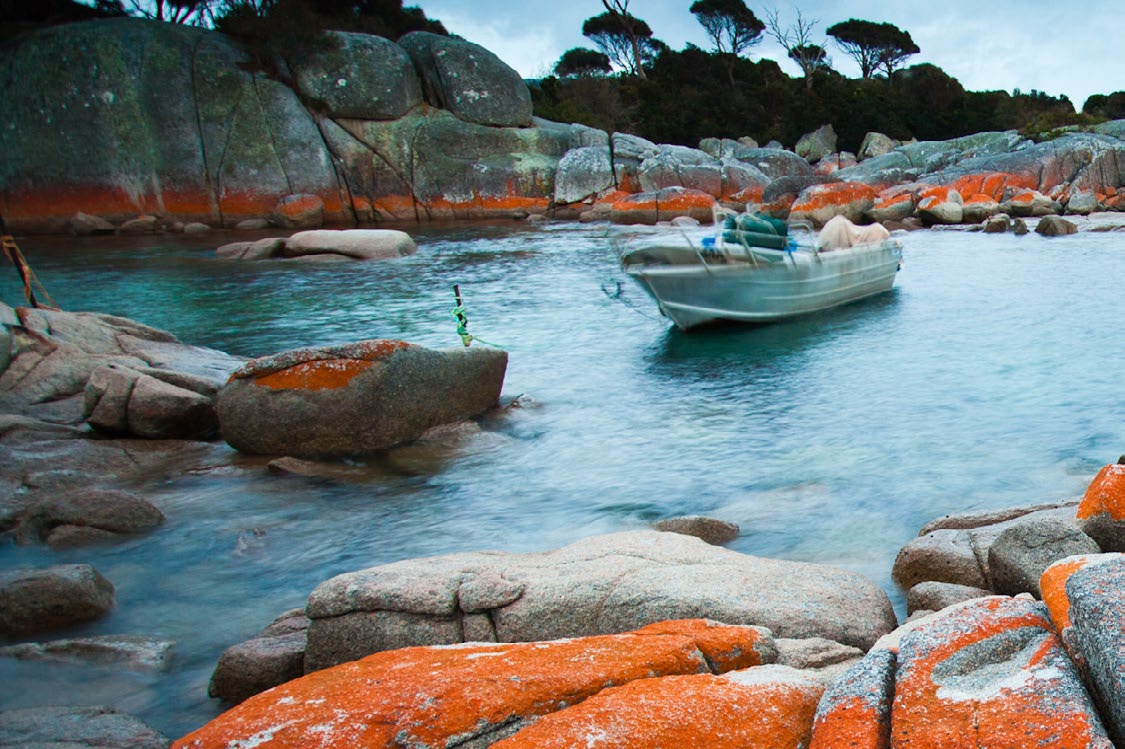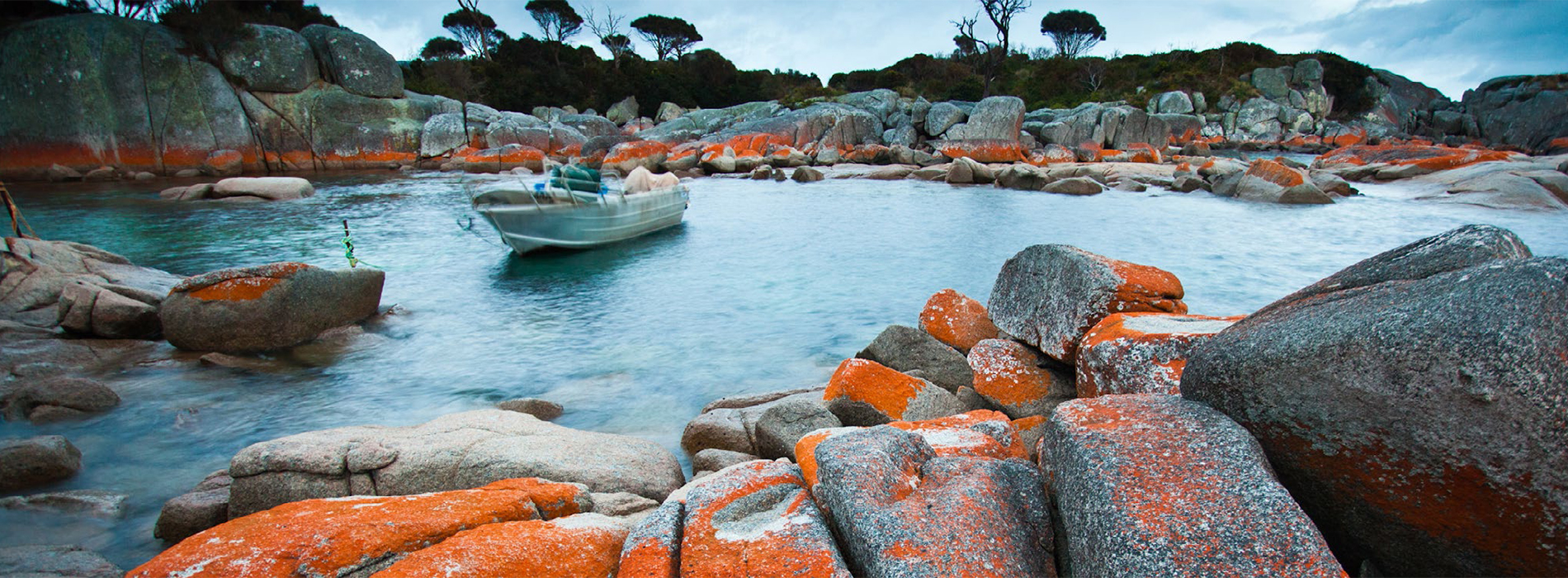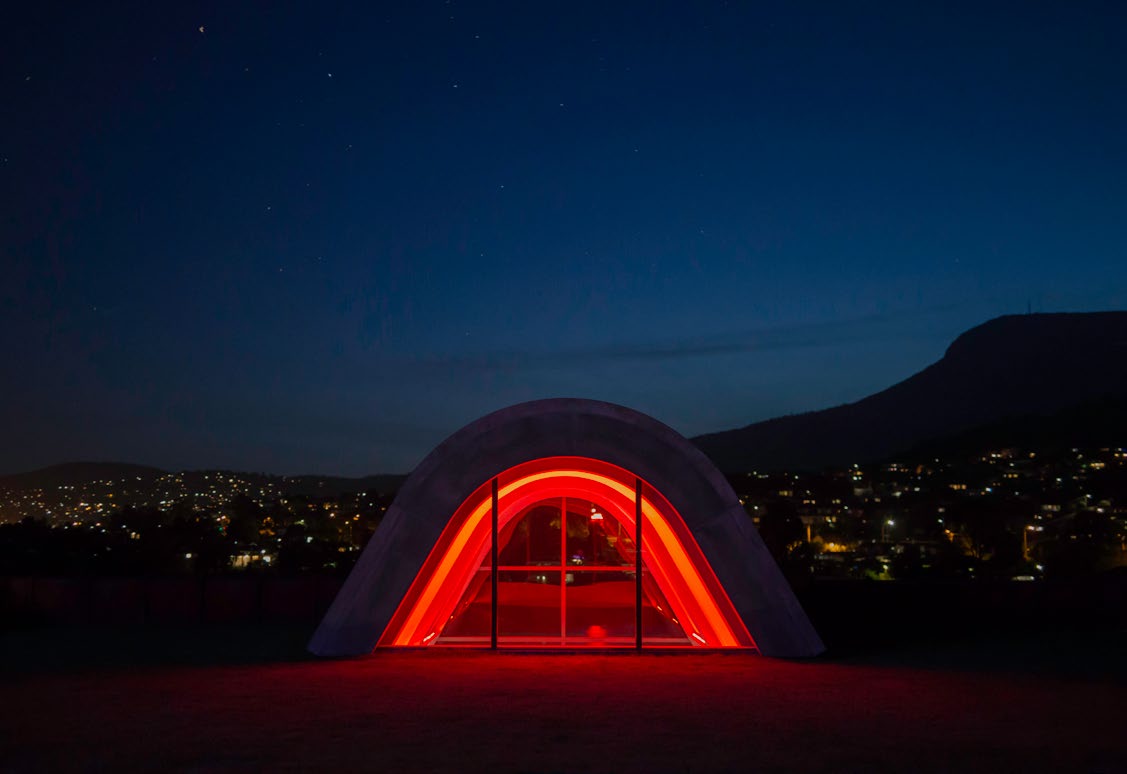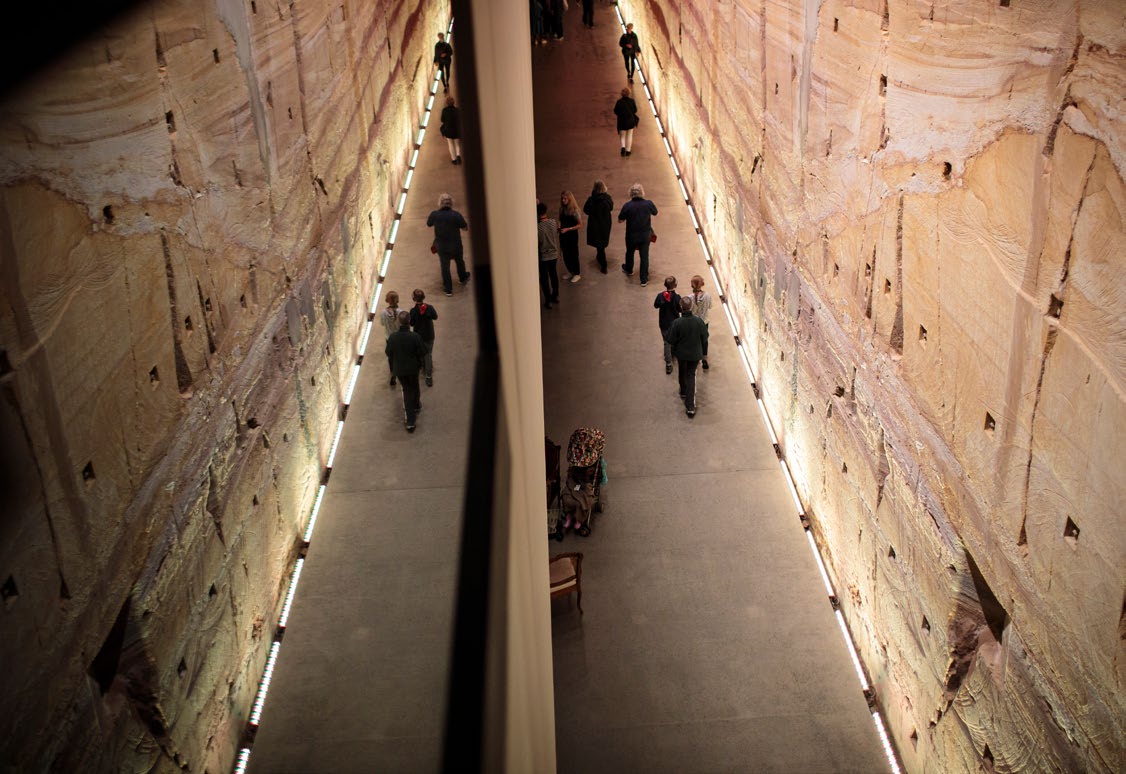
Culture Etc.

Above: Orange rocks at the Bay of Fires. Photo: Tourism Tasmania & Kathryn Leahy.
Down Under
Long overlooked as a tourist destination, Tasmania offers both glorious wilderness and the wildest of art.
By Tess Nichol
The first direct flight from Auckland to Hobart in 23 years touched down slightly ahead of schedule, about 11am on 22 April. A result of the short-lived trans-Tasman bubble, the flight allowed New Zealanders to explore a place many have long overlooked. Spending a stint earning remarkably high wages in Perth, Melbourne or Sydney is de rigeur for Kiwis in their early 20s, and the Gold Coast is practically a family-holiday rite of passage. But Tasmania has never been high on most people’s list of destinations. A couple of years ago, however, I spent 10 days roaming around Tasmania in a rental car, and was so charmed by it that I have asked friends from my own time spent living in Melbourne if, on my next trans-Tasman trip, they’d meet me in Hobart instead.
Tasmania is a place of sublime beauty. Snow-capped mountain ranges, lush and dense forest, wide open bodies of water and sparkling white beaches stretching for miles all make up this island’s remarkably changeable landscape. In many places, a sense of moody isolation dominates, particularly in the west where mist hangs low in the valleys and sheer cliff faces close the sky in. Its natural wonder is evoked in Richard Flanagan’s widely acclaimed debut novel, Death of a River Guide, published in 1994. Much of the novel takes place on and along the banks of the Franklin River, a wild wonder which Flanagan’s rich prose paints as awe inspiring — and terrifying.
But not terrifying in the same way as the vast and scorching hot outback or the crocodile-infested waters of the Northern Territory. There are no crocs here, and while there is one particularly venomous kind of ant and three dangerous snake species, you’re less likely to encounter them here than elsewhere. About two people die of snakebite in Australia every year, but until 2020 there had only been one such death in Tasmania in 43 years. Rather, Flanagan’s depiction of the Franklin is of a river which can turn on a dime. What starts as a rafting adventure holiday ends in mayhem, as heavy rain causes the river to rise beyond anyone’s ability to navigate it. Stuck at the bottom of a cavernous ravine with no way out, water churning past them, the characters realise the exhilaration they were seeking, of giving themselves over to an unmediated experience of the wild, has turned to a situation of pure terror. “They felt consumed by the river, felt that they had allowed it to chew them up,” Flanagan writes. “[They] were now being digested in its endlessly winding entrails that cut back and forth in crazed meanderings through vast unpeopled mountain ranges. And it frightened them, these people from far away cities whose only measure was man.” Most are saved, by luck more than anything, but help comes after the river has already claimed more than one life.
Terrifying too is the history of what was once known as Van Diemen’s Land. Flanagan describes a colonial outpost forged in shame and violence, trauma rippling through generations to a bleak present where characters struggle to make sense of the ever-present terror felt in their very insides. Hobart and other towns are depicted as steeped in hopelessness, drunkenness, meanness of spirit. In the novel as in real life, a relatively high level of unemployment, particularly for young people, is an ongoing problem. But where Flanagan explored the way hard lives can make hard people in his unflinching yet generous style, mainland Australia’s attitude to Tasmania hasn’t always been so nuanced. The island state has typically been considered a little backward — too small, too insular, too far away from everything else.
Hobart’s art museum, MONA, has been described as “a mashup of the lost city of Petra and a late night out in Berlin”.

Outside MONA at night. Photo: MONA and Jesse Hunniford.
I read the book for the first time over summer, and was struck by how much had changed in the 27 years since Flanagan wrote it (though it also, perversely, made me want to return to raft down the Franklin myself). Since the early 2010s, Tasmania has become a steadily more desirable location for an increasingly diverse range of tourists. Its natural beauty has always been a drawcard for the more rugged traveller, but now the state holds appeal for fans of natural wine and aggressively local organic produce, too.
The transformation of Tasmania’s reputation is in large part thanks to the extraordinary success of the bizarre and endlessly fascinating Museum of Old and New Art (MONA), which hangs above the River Derwent to the north of Hobart. The passion project of eccentric multi-millionaire and art collector, David Walsh, MONA opened to the public in early 2011. It was dedicated, Walsh said, to sex and death (an ordinary remark from someone whose car park at the museum is marked “Reserved: God”). Walsh grew up in a working-class area in Tasmania and made a fortune by developing a gambling system for betting on sport and horse racing. In 2009, he made a bet with French artist Christian Boltanski that Boltanski would die before he turned 65. Walsh wanted to buy the right to film the artist at work in his studio and transmit the images back to Tasmania as a piece of live performance art. Instead of a lump sum, Walsh offered to pay him in ongoing yearly instalments. If Boltanski died before turning 65, Walsh would have got the work for cheap, if he outlived 65, Walsh would overpay. “It would be absolutely great if he died in his studio,” Walsh said in an interview with the New York Times about the bet. “But I don’t think it’s ethical to organise it.” Walsh lost that bet — Boltanski is still kicking along at 76 years old.
MONA was described (by Richard Flanagan again) as “a mashup of the lost city of Petra and a late night out in Berlin”. Not one for piety, Walsh seemed motivated to create the museum out of a personal desire to exhibit art you would be unlikely to find anywhere else. On one wall is a row of more than 150 clay casts of vulvas. Another exhibition is just a heavily tattooed German man named Tim who sits quietly for six months of the year. There is a machine which creates realistic human poo, using similar methods of digestion as humans do. When I visited, I spent half an hour ensconced in what felt like a psychedelic space cave, sparkling silver with flashing alien light displays emerging from the undulating walls. An angular tank filled to the brim with sump oil was remarkably beautiful, the black of the oil reflecting the brutalist slabs of recessed concrete which towered above it. The museum itself is like a labyrinth, almost impossible to follow in any kind of orderly way. The exhibitions are split over levels and there are too many nooks and crannies to feel sure when you leave that you saw everything.

Inside the labyrinth that is MONA. Photo: MONA and Rémi Chauvin.
The museum has had such an impact on Tasmania’s economy that it has its own name: the MONA effect. Nearly two million people visited MONA in its first five years. In 2019, right before Covid-19 hit, Tasmania was recording about 300,000 tourists a year. Many may have been drawn by MONA but were keen to explore further afield, too.
Because while yes, you really should set aside at least a whole day to take in what may be the most original art museum you will ever visit, it’s far from the only attraction. If you come in June, you should look up what’s on at Dark Mofo, the annual midwinter music and arts event in Hobart where live performances and installations are held all over the capital at all hours of the day and night. The sheer amount of things to see and do earned it the nickname “dark FOMO” from some friends of mine. It runs this year from 16–22 June.
To visit Tasmania and stay in Hobart would be a grave mistake, however. I would recommend travelling by car or camper, and trying to keep your itinerary as flexible as possible. Tasmania is a fun place to explore when you have the freedom to follow your nose. What I found so fascinating about the place is the way the land changes as you traverse it. Sometimes you’ll be looking out at a view which couldn’t be more Australian, all low shrub and gorgeous rich red dirt, only to drive an hour or so west and wonder if you’ve somehow ended up back in New Zealand. The craggy mountains foregrounded by lush grassy fields could have been transplanted from Fiordland.
Tasmania’s remarkably changeable landscape means that sometimes you’ll be looking out at a view which couldn’t be more Australian, all low shrub and gorgeous rich red dirt, only to drive an hour or so west and wonder if you’ve somehow ended up back in New Zealand.

The Franklin River. Photo: Stu Gibson.
We started in Hobart and went north along the east coast, through to Wineglass Bay (it’s only about 45 minutes to the lookout, and the views are spectacular), and on up to Bay of Fires, staying at the water’s edge in dusty campsites on the way. The Bay of Fires is reminiscent of the white beaches of Perth, and the sand is so fine it squeaks beneath your feet. Along the shoreline, the beach is rimmed with the most incredible orange-hued rocks whose sides look like they are being licked by flame (it’s just lichen). That is not what the bay’s named for, though. The bay’s name was coined by an English navigator in the late 1700s, who saw the fires of Aboriginal people on the beaches. You can clamber along to find rock pools to swim in if it’s warm enough, or just stand atop the highest rock and look out to the endless turquoise of the Tasman Sea to the east.
Then, head inland to Derby, where you’ll find a much-hyped floating sauna at the end of a short jetty. Two small wooden shed-like structures, one a traditional wood-fired sauna and the other a changing room, jut out over the shores of the lake, a little oasis of calm on the still waters. (Be aware you will most likely need to book this in advance.)
One of Tasmania’s most popular places to visit is Cradle Mountain. If you’re heading here from the east, you’ll likely feel the temperature drop as you get into the region — prepare accordingly with warm clothes and wet-weather gear. Summiting is a full day’s walk and snow at the top of Cradle is not uncommon, in which case you’ll be asked not to try anyway. But that’s alright, there are plenty of shorter tracks which take you high enough for spectacular views of surrounding mountains and mountain lakes. We took a bus out then walked for several hours past lakes and up rocky, dramatic mountainsides. It snowed on us when we reached the top — surreal for a day which had started out with a dip in the (admittedly freezing) ocean.
The most special animals we spotted were the wombats, funny little potatoshaped balls of fur with big snuffly noses and square poos.

A wombat snuffles about. Photo: Laura Helle.
On our bus ride out as the sun began to set, scores of animals emerged in the grassy fields around the mountain’s base. The most special were the wombats, funny little potato-shaped balls of fur with big snuffly noses and square poos. You’ll also spot wallabies and kangaroos, but good luck finding a Tasmanian devil — though you will likely hear their horrifying scream in the night at some point.
We then made our way circuitously back to Hobart, before catching the car ferry over to Bruny Island, a journey of about 30 minutes. The island feels quiet and not unlike the more remote parts of Northland, particularly when you drive north up the spit, a thin stretch of road bordered by sandy beach, which leads you eventually to a lighthouse and a view out to the ocean. Bruny is crisscrossed with walking tracks (a friend well experienced in day hikes recommends the Fluted Cape walk), and you’re never far from the coast, which often includes views of dramatic capes and cliff faces. The bush here is more typically Australian — dry and sparse, with thin-trunked trees and dappled light falling on red-dirt ground.There’s also a lovely cheese factory where you can eat quite a lot of free samples before someone asks you to buy anything.
In fact, Tasmania is known for the quality of its wine and produce, and it’s not hard to find good food wherever you go. A particular joy was the abundance of often incredibly well-priced oysters along the coast — we ate them for breakfast nearly every day. There are also plenty of regional festivals and events, many of which centre around an area’s produce, such as the Huon Valley, an apple-growing region which hosts a lively midwinter festival every July.
While international travel was at a halt due to Covid-19, and prior to the current outbreak, domestic tourists flocked to Tasmania from mainland Australia. Much like the New Zealanders who finally took the time to check out parts of the country they’d never made the time to visit before, Australians seemed to recognise they had a bit of a hidden gem one short plane ride (or a rather longer ferry trip) away. It’s worth noting that Tasmania has had enormous success containing the virus (like us, being an island has probably helped). Though the trans-Tasman bubble may be paused for now, I reckon that, when we’re able to, you’d be wise to get over there while there’s the chance to hog it for ourselves.
Tess Nichol is the deputy editor of North & South.
This story appeared in the June 2021 issue of North & South. Parts have been amended to reflect that the trans-Tasman bubble is no longer open.

